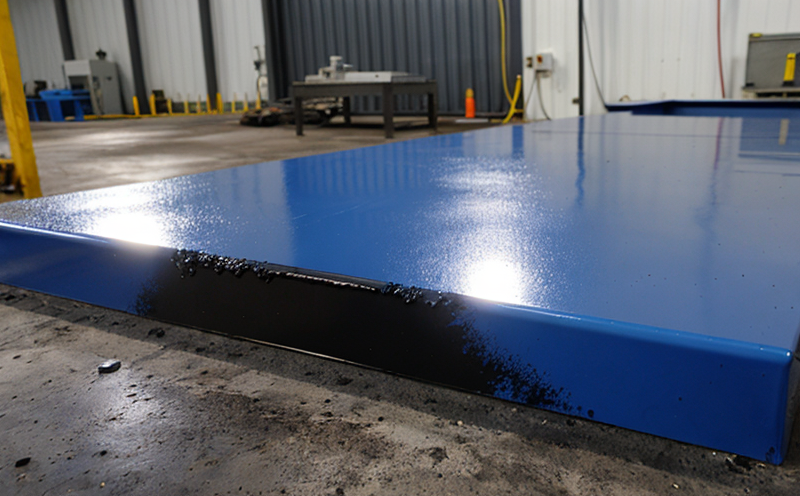ASTM B117 Salt Spray (Fog) Corrosion Testing of Coatings
The ASTM B117 salt spray test is a standardized procedure used to evaluate the resistance of various materials, particularly coatings and plating, against corrosive environments. This test simulates real-world conditions where metal surfaces are exposed to salt spray, which can accelerate corrosion processes. The primary objective is to determine how long a specimen remains uncorroded under specified environmental conditions.
The ASTM B117 method involves exposing the coated or plated specimens in a chamber filled with a fine mist composed of sodium chloride (NaCl) solution. The salt particles suspended in the fog can simulate the corrosive nature found on coastal areas, industrial environments, and other high-humidity locations. This test is widely used by industries such as automotive, aerospace, construction, and electronics to ensure that coatings and plating meet quality standards and are durable enough for their intended applications.
The testing process can vary in duration from a few hours up to several weeks, depending on the expected service life of the coating or plated item. In industrial settings, a common practice is to expose specimens for 48 hours, but longer durations may be necessary for more robust evaluations. The test chamber maintains specific conditions including temperature and relative humidity levels which are critical for accurate results.
Preparation of samples prior to testing requires careful attention. Specimens must be clean and free from contaminants that could affect the outcome. Depending on the type of coating or plating, different methods may be required to prepare the surface before exposure to the salt mist. It's important to note that some coatings might not adhere well when exposed directly to salt spray; these cases necessitate additional procedures such as applying a primer layer.
The test results are interpreted based on visible signs of corrosion, which include rust formation or changes in coloration and texture of the coating. These visual assessments help determine whether the material has retained its integrity after exposure to the corrosive environment. Reporting typically includes detailed descriptions of any observed degradation along with time intervals at which it occurred.
| Parameter | Description |
|---|---|
| Temperature Range | 35°C ± 2°C |
| Relative Humidity | ≥95% |
| Saline Solution Concentration | 5% NaCl (mass/volume) |
| Exposure Duration | Duration varies; up to 96 hours is common. |
Understanding the nuances of ASTM B117 salt spray testing helps quality managers, compliance officers, R&D engineers, and procurement professionals make informed decisions regarding material selection. By ensuring that coatings and platings meet stringent standards through rigorous testing processes like ASTM B117, manufacturers can enhance product reliability while maintaining competitive edge in demanding markets.
Scope and Methodology
- The test involves placing the specimen inside a chamber where it is exposed to a fine mist composed of sodium chloride (NaCl).
- The temperature within the chamber should be maintained at approximately 35°C ± 2°C.
- Relative humidity must exceed 95% during exposure.
- A saline solution concentration of 5% NaCl is used to create the corrosive environment.
The testing procedure begins with careful cleaning and preparation of the specimen. Once prepared, the sample is placed into the chamber where it remains exposed to the salt mist for a predetermined period. During this time, observers monitor the material closely for signs of corrosion such as rust formation or changes in appearance.
At regular intervals throughout the test, observations are made and recorded. If significant corrosion occurs before the end of the scheduled exposure duration, additional tests might be conducted to assess longer-term performance. Upon completion of the prescribed exposure time, thorough inspections are performed on all tested materials to evaluate their resistance levels.
Benefits
- Identifies coatings with superior corrosion resistance early in development cycles.
- Aids in selecting appropriate materials for specific environmental conditions.
- Ensures compliance with industry and regulatory standards related to coating durability.
- Reduces costs associated with premature failures of protective layers due to insufficient quality control.
- Promotes consistent performance across batches or lots during mass production processes.
Quality and Reliability Assurance
The ASTM B117 salt spray test plays a crucial role in quality assurance programs by providing objective data on the effectiveness of surface coatings. This information allows manufacturers to fine-tune their production processes, ensuring that end products consistently meet or exceed customer expectations.
By incorporating ASTM B117 into standard operating procedures, companies can demonstrate commitment to excellence in product development and manufacturing. Rigorous adherence to this method helps build trust among customers who rely on dependable performance from coated items across various sectors including automotive, electronics, construction, and more.





